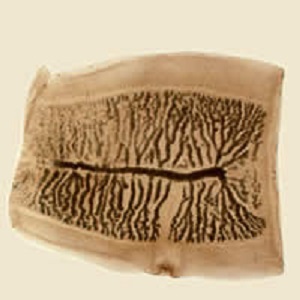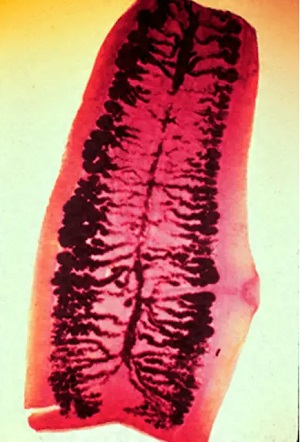Taenia saginata - Laboratory Diagnosis, Reservoir, Transmission, Treatment
Laboratory Diagnosis of Taenia saginata
The lab diagnosis of Taenia saginata is done by demonstration of eggs, head, or gravid proglottids in the feces.
Sample
stool
Microscopy
Most commonly, Taenia saginata eggs can be observed while scolex and proglottids are less frequent.
Detection of eggs
It is essential to collect 2 to 3 stool samples for the detection of the parasite because eggs and segments are not regularly shed in the stool.
The eggs, if present in the perianal area, can be demonstrated by the cellophane-swab technique. This technique is mostly used for diagnosis of Enterobius vermicularis infection and has a sensitivity of 85% to 90%.
Acid-fast staining of the eggs can be used to differentiate Taenia saginata from T. Solium as Taenia saginata eggs are acid-fast in nature while T. solium eggs are non-acid-fast.
Cellophane-swab technique
It is also called the transparent adhesive tape test or Scotch tape test and is a quick, cost-effective, and painless test. Multiple samples may be collected at home early in the morning before and submitted later to the laboratory/doctor's office.
In this method, a sample from the skin around the anus is collected and examined. The sample must be retrieved before the patient has gotten out of bed, used the bathroom, or taken a bath.
the sticky side of a piece of clear tape (such as Scotch tape) is applied briefly to the skin around the patient’s anus
any eggs or in some cases proglottids present on the skin will stick to the tape
sticky side of a piece of the tape is pressed to a microscope slide and viewed under a microscope

Image: T. saginata - unstained gravid proglottids (Source: cych.org)
Detection of proglottids
Demonstration of gravid proglottids, obtained from feces or a person’s under clothing, is essential for species identification of Taenia. Injecting stains such as India ink through the genital pore of the proglottids helps in the demonstration of lateral uterine branches
The gravid proglottids are washed with clean water and placed between two slides
the two sides are held together by adhesive tape
proglottids are then examined by hand lens
presence of 10 to 20 lateral branches on each side of the uterine stem in the uterus identifies the tapeworm as Taenia saginata
* T. solium has only 7 to 12 lateral branches on each side of the uterine stem

Image: T. saginata - gravid proglottids stained with India ink (Source: cych.org)
Detection of scolex
Demonstration of scolex can confirm Taenia infection. Taenia saginata scolex is differentiated from T. solium scolex as Taenia saginata lacks a row of hooks or rostellum.
This is rare as the scolex is not always recovered following treatment.
Antigen Detection in stool
Coproantigen detection test
Taenia saginata infection can also be detected by a coproantigen detection test. They use an antigen-capture ELISA using polyclonal antisera targeting Taenia. The specificity and sensitivity depend on the platform and quality of reagents but can be used for the identification of genus but does not differentiate between species.
Serodiagnosis
These methods are based on the demonstration of specific Taenia antibodies in the serum but have limited advantages in the diagnosis of tapeworm infection.
Indirect Haemagglutination (IHA)
Inredt Fluorescent Antibody (IFA)
Enzyme-Linked Immunosorbent Assay (ELISA)
Molecular diagnosis
Molecular methods are used to detect and differentiate between Taenia species eggs and proglottids.
DNA probe
high sensitivity and specificity
the disadvantage is that if only segments are present and eggs are absent in the sample, it shows a false negative
PCR
detects Taenia eggs in the stool samples
very high sensitivity- even a single egg in the sample can detect and differentiate between Taenia species
Treatment of Taenia saginata
drugs of choice include Praziquantel and niclosamide
the anti-parasite drug must be accompanied by purgatives to expel the dead tapeworm along with the feces
Prevention, Control of Taenia saginata
preventing contamination of freshwater sources from human feces
not using human feces as fertilizers
treatment of infected persons/reservoirs
improving general sanitation
avoid eating raw or undercooked meat
freezing the meat at -7°C to 10°C for 24 to 48 hours will kill cysticerci